Monstera Deliciosa Care: How to Grow Swiss Cheese Plant (Monstera)
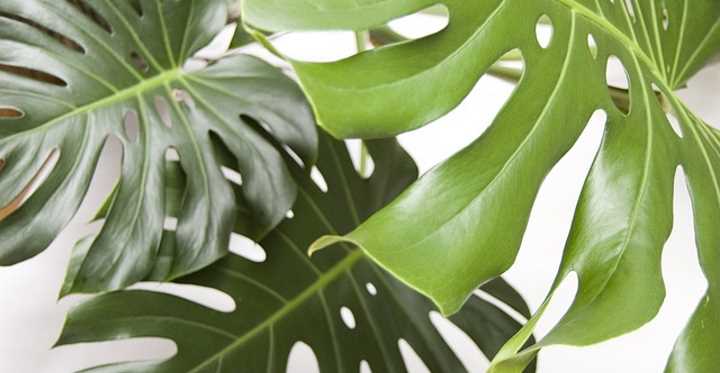
Monstera Deliciosa—also called Swiss cheese plant—is a tropical climbing vine plant with large glossy green leaves. The most recognizable feature of the Swiss cheese plant is the heart-shaped leaves with deep splits or perforations. These splits start as small holes that resemble the holes in Swiss cheese. It is easy to care for this large tropical plant at home.
How to care for Monstera deliciosa: You should plant a Swiss cheese plant in rich, well-draining soil, and water it when the soil is partly dry. Place your Monstera deliciosa indoors in bright, indirect light and temperatures between 70°F and 75°F (21°C – 24°C). To encourage healthy growth, fertilize monthly, and mist the leaves weekly.
There are around 50 species of this exotic-looking plant in the plant family Araceae. Apart from the Monstera deliciosa, other species include Monstera obliqua, Monstera adansonii, and Monstera pinnatipartite.
Some common names for M. deliciosa include Swiss Cheese Plant, Split-Leaf Philodendron, Mexican Breadfruit Plant, Hurricane Plant, and Window Leaf Plant. Whatever you decide to call your Monstera, its large glossy split leaves will grace the décor of any modern interior.
In this article, you will learn how to look after this easy-to-care-for tropical plant. At the end of the article, you can find out about more species of Monstera plants, including the rare variegated Monstera.
What is a Swiss Cheese Plant (Monstera Deliciosa)?
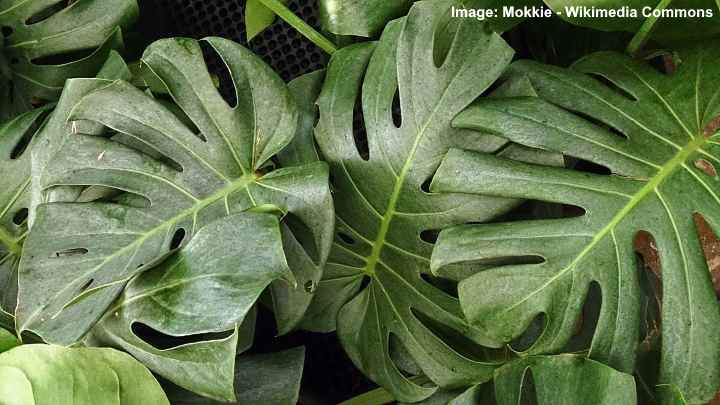
The Monstera deliciosa is native to Southern Mexico and Central America. These popular houseplants thrive in environments similar to tropical rainforests. However, that doesn’t mean you have to turn your home into a humid jungle to care for these plants indoors. Average room temperatures and regular misting are enough to look after Swiss cheese plants.
Monstera deliciosa is a species of flowering tropical plant. Unfortunately, it is rare when Monstera plants flower indoors. In their native environment, the plants produce stunning yellowish or pure white waxy flowers. The flower shape is similar to other arum plants in the Araceae family—for example, calla lilies which are a type of arum-lilies. The flower spathe turns into an edible fruit that has a sweet banana-like taste. (1)
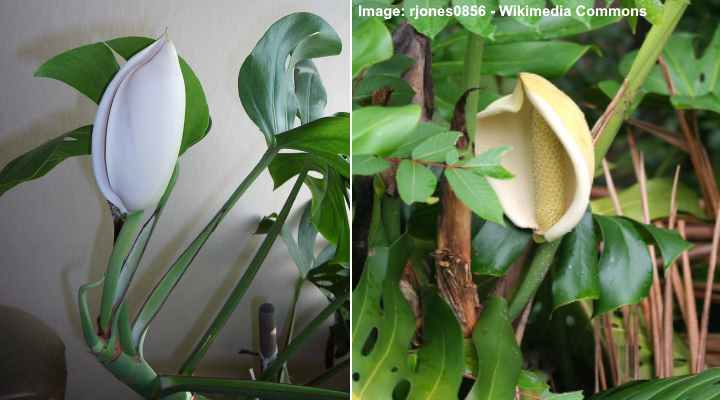
Monstera deliciosa flower
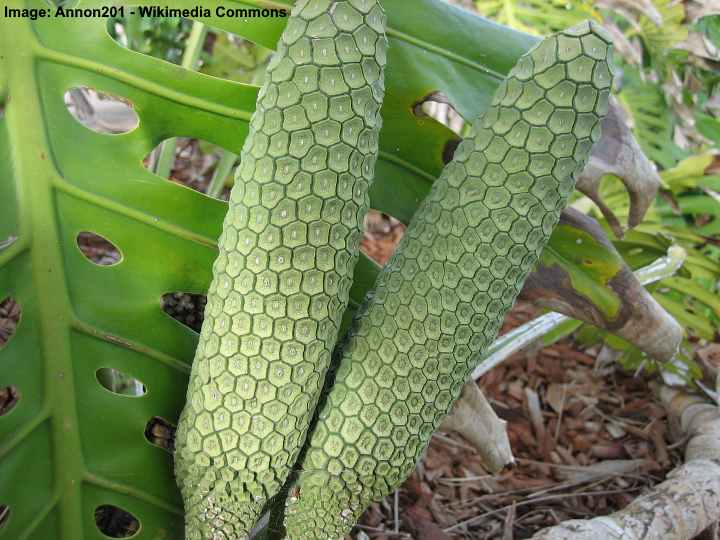
Monstera deliciosa fruit
These climbing vines can reach heights of up to 66 ft. (20 m) in the wild. When growing indoors in pots, the thick stems will need support, and aerial roots will attach to the support. Indoors, Monstera deliciosa can grow to 8 ft. (2.4 m) tall and will need plenty of room for its vast foliage.
How to Care for Monstera Deliciosa (Swiss Cheese Plant)
Even though Monstera deliciosa plants are low-maintenance, they have a few care requirements. The two most important factors when looking after a Swiss cheese plant is to water it properly and have it in a bright room indoors.
Let’s look in more detail at how to make your M. deliciosa thrive as a tropical houseplant.
Monstera Deliciosa Light Requirements
Swiss cheese plants grow best indoors when they are in bright rooms but away from direct sunlight. If your Monstera container is near a south-facing window, make sure it’s protected from the sun. Monstera plants also grow in low-light conditions where their growth rate will be slower.
Monstera deliciosa plants can grow in offices and dimly-lit rooms. However, you may notice that they don’t develop splits or perforations in the glossy leaves. Put in a bright location to help leaves look their best.
You can also grow your monstera outdoors during the summer. Gradually acclimatize your plant outside when the temperature doesn’t drop below 50°F (10°C) during the night. Ideally, daytime temperatures should be at least 68°F (20°C) for the best growth. Put your container on your balcony or patio and protect it from direct sunlight.
How to Water a Swiss Cheese Plant
Water a Swiss cheese plant only when there is no moisture in the top part of the potting mix. The sign when your Monstera needs water is when the top 1” to 2” (2.5 – 5 cm) are dry. Thoroughly water your houseplant until water drains from the container’s drainage holes. Deep watering ensures that enough moisture gets to the roots.
The best care tip for watering a Monstera deliciosa is to wait until the potting soil is party dry. It doesn’t matter if you forget to water your houseplant occasionally. Over-watering can cause root rot and weak growth. You will also need to water more often in spring and summer than in winter.
Best Temperature for Monstera Plants
Average room temperatures are ideal for growing a Monstera plant indoors. To ensure leaves are healthy and glossy, keep room temperature between 70°F and 75°F (21°C – 24°C). If you feel chilly, then your Swiss cheese plant will also suffer from the cold.
When caring for any tropical houseplant—and Monstera deliciosa is no exception—keep them away from drafts or hot surfaces. Unsuitable locations would be near a radiator or in the airflow from an air-conditioning unit. Also, try to avoid sudden extreme changes in temperature to prevent stressing your plant.
You can grow a Monstera deliciosa outdoors if you are in zones 10 or 11. If you want to have your plant outside, remember that any temperature below 50°F (10°C) will kill your tropical rainforest plant.
Humidity Requirements to Grow Monstera Deliciosa
Swiss cheese plants require humid conditions to grow, but they are less demanding than other tropical indoor plants. To get humidity levels right, mist the leaves once a week or wipe them with a damp cloth to remove dust. The best time to spritz the split-leaf blades is in the morning.
Growing together with other houseplants is another way to ensure your Monstera deliciosa gets enough moisture.
The easiest way to increase humidity levels in a room with dry air is to create a pebble tray. Place your Monstera plant pot on a tray filled with pebbles. Fill enough water in the try until it is half-way up the stones. The water helps create a humid environment for a Swiss cheese plant without having to remember to mist the leaves regularly.
Monstera Deliciosa Soil
The best potting mix for a Swiss cheese plant is a well-draining peat-based medium with perlite worked into the soil. This type of light, aerated potting soil doesn’t retain too much moisture which could harm the roots. The peat base also provides plenty of nutrients for a healthy tropical plant.
When you water a Monstera deliciosa, the water should drain quickly. If water tends to sit on top of the soil, you need to add some peat or perlite.
It is also essential to choose the right type of pot for your plant. Monstera plants can grow between 3 and 6.5 ft. (1 – 2 m) and need a large container for stability. However, avoid the temptation to put your plant in a container that is too big too soon. An oversized pot can make it difficult to get moisture levels ideal.
Fertilizer to Feed a Swiss Cheese Plant
During the growing season—from spring until the end of summer—fertilize your Monstera deliciosa once a month. Use an all-purpose, water-soluble houseplant fertilizer. Getting the right balance of nutrients ensures healthy growth and shiny green leaves.
Stop feeding your Swiss cheese plant in the fall and winter. The plant doesn’t grow too much during these months, and over-fertilizing the plant can poison the soil.
To ensure proper care, flush the soil every three months or so. Flushing helps get rid of excess mineral salts that can buildup in the potting mix. To do this, slowly pour water through the soil until it drains out the pot. Allow all water to drain before putting the plant back in a bright location.
Repotting Monstera Indoor Plant
As your Swiss cheese plant grows, you will need to repot it in a larger container. Signs that it is time to repot include slow growth, poor drainage, or roots sticking out the drainage holes. Wait until spring to repot and choose a container 1” to 2” wider than the current one.
If you don’t want your Monstera plant to grow taller, repot in a similar-sized pot. Refreshing the potting soil is an excellent way to help to revive your houseplants.
Here are instructions to repot a Monstera deliciosa:
- Gently remove the plant from its container and shake excess soil from the roots.
- Check the roots for signs of damage and prune as necessary. If you are planting in a similar-sized container, trim the roots.
- Put fresh potting soil in the new container and plant your Monstera at the same height in the pot as it was growing before.
A few tips on choosing the right pot for your Monstera deliciosa:
- Clay or terracotta pots retain less moisture than plastic ones—so, you will have to water more often.
- Always choose pots with drainage holes to prevent the plant from being too moist.
- Monstera plants need deep pots because of their deep root system.
Pruning Monstera Deliciosa
It is easy to prune a Swiss cheese plant by cutting the leaf and stem from the main stem. The only time you need to prune a Monstera deliciosa is when it becomes too large or has dead or damaged blades.
Some Monstera deliciosa pruning tips:
- Pruning large foliage results in an unkempt-looking plant and is not the best way to restrict its growth.
- Always use sterilized pruning sheers to prevent spreading disease.
- Wear protective gloves because Monstera plants have toxic sap that can cause skin irritation if you’ve got sensitive skin.
Propagating Monstera Deliciosa
Propagate your split-leaf Philodendron by stem cuttings. Snip off a section of your Monstera plant that has at least two aerial roots. Plant the cut stems in fresh Monstera potting mix. Your tropical plant should start rooting in four weeks.
If your Monstera deliciosa is getting too big for your room, you can cut the main stem into one-foot (30 cm) sections. Propagate the same way as cheese plant cuttings.
Is Monstera Deliciosa (Swiss Cheese Plant) Toxic?
Yes. The American Society for the Prevention of Cruelty to Animals (ASPCA) lists Swiss cheese plants as toxic to cats, dogs, and other animals. Coming in to contact with the sap by ingesting parts of the plant can cause irritation, vomiting, and difficulty swallowing. (2)
Common Monstera Deliciosa Diseases
Being a low-maintenance, hardy tropical plant, few diseases affect Monstera deliciosa. The most common issue is root rot due to over-watering. Sitting in damp, soggy soil can destroy the roots and kill your plant.
If the root rot is extensive, you may see the glossy blades turn black and become mushy. You can try to repot the Monstera in fresh potting mix and then only water it when the top two inches (5 cm) of potting soil is dry. If root damage is extensive, then there is no chance of bringing a dying Monstera back to life.
Pests that Affect Monstera Deliciosa Growth
The two types of pests to affect Swiss cheese plants are mealybugs and spider mites. However, bug and mite infestations are not typical and the Monstera is quite pest resistant.
If spider mites from other houseplants have affected your Monstera, you will notice fine spider webs on your plant. It’s essential to get rid of Monstera spider mites as they can cause your plant to die eventually.
Mealybugs look like small white fluff where the leaves join the stem.
Check out this article to find how to get rid of houseplants naturally using neem oil or insecticidal soap.
Common Question About Growing a Swiss Cheese Plant
Why are my Monstera leaves yellow and drooping?
Watering issues are usually the reason for yellow, drooping leaves.
Lack of water is the most common reason why Monstera plants look as if they are dying. If the green leaves start to turn yellow and droop, then thoroughly water your plant.
If you notice that the soil is already damp, then over-watering could be to blame. So, wait until the top 1” or 2” (2.5 – 5 cm) of the soil is dry before watering. Make sure that the pot isn’t too large for your tropical houseplant as oversized pots tend to hold too much moisture.
What are brown spots on Swiss cheese plant leaves?
Too much direct sunlight causes leaf burn that looks like brown spots. Move the Monstera plant pot to another location where there is filtered sunlight.
Another reason for brown leaf spots could be a lack of humidity. To revive your Monstera, mist the leaves regularly to increase moisture.
Do Monstera leaves grow back?
It’s natural that older leaves fall off the Swiss cheese plant. Usually, new leaves don’t grow back on bare stems. However, it is easy to propagate Monsteras and plant in the same pot. Planting smaller cut stems gives the tall climbing vine a fuller appearance.
How big does a Monstera grow?
Swiss cheese plants are vigorous vines that continue to grow, even when you pinch off the top stems. Indoors, a Monstera plant can grow to between 6 and 8 ft. (2 – 2.4 m) and have a wide spread. The heart-shaped split leaves can be between 10” and 35” (25 – 90 cm) long and up to 30” (75 cm) broad.
How fast does Monstera deliciosa grow?
Under the right conditions, Monstera plants can grow fast. However, growth will be slower in the fall and winter. Also, soil type, temperature, and humidity all affect the growth rate.
Other Types of Monstera Plants
Let’s look at some different types of split-leaf Monstera plants that are excellent as tropical houseplants:
Monstera deliciosa albo variegata plant
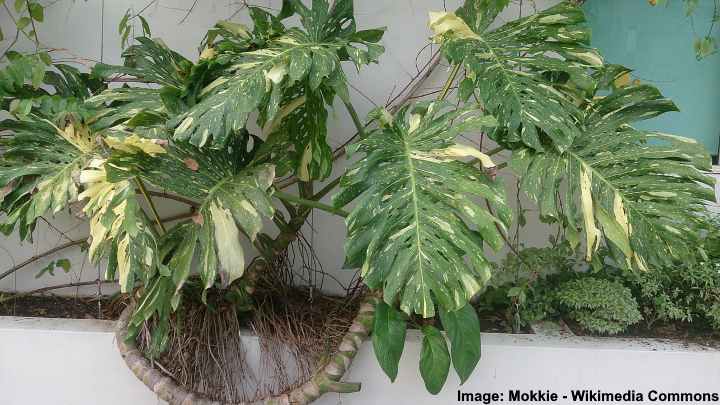
The rare variegated Swiss cheese plant has large dark green with creamy-white variegation. Some more unusual Monstera deliciosa variegated plants have leaves that don’t have splits on one half, and the variegated part has deep splits.
Monstera obliqua
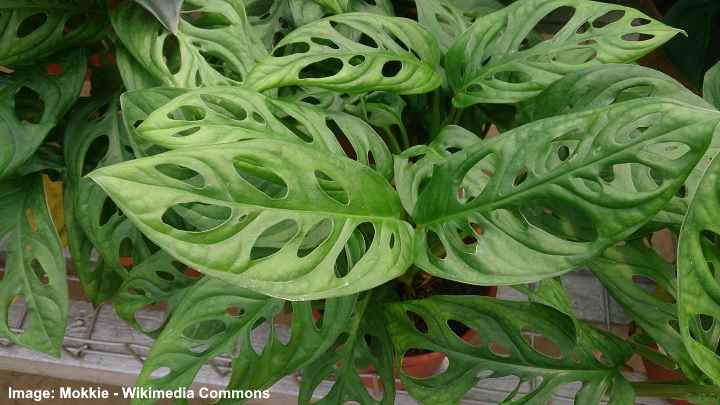
The Monstera obliqua is a rare cultivated plant with thin papery leaves and large holes in the mature leaves. On some species, the leaves look disheveled due to several large holes in the leaves.
Monstera adansonii

Also called the ‘5 Holes Plant’ or ‘Monkey Mask,’ the Monstera adansonii has thick, leathery leaves that are smaller than the deliciosa species. This small houseplant is easier to manage indoors than a sizeable Swiss cheese plant.
Monstera pinnatipartita
The pinnatipartita has ovate leaves with significant wide splits.
Monstera siltepecana
Similar to the Monstera adansonii, this cultivar has leaves with holes that also resemble Swiss cheese. Unlike the M. deliciosa, the M. siltepecana doesn’t develop split blades but they several have holes in the middle of the leaf.
Related articles:
- How to Grow Colorful Coleus Plant Indoors and Outdoors
- Monstera Adansonii Care: How to Grow Swiss Cheese Plant
- The Best Closed Terrarium Plants (with Pictures)
